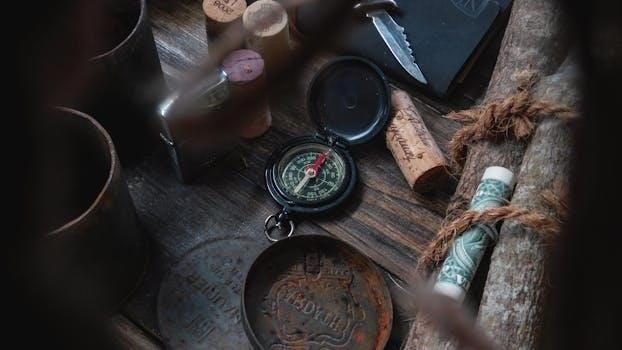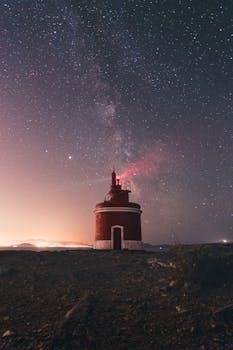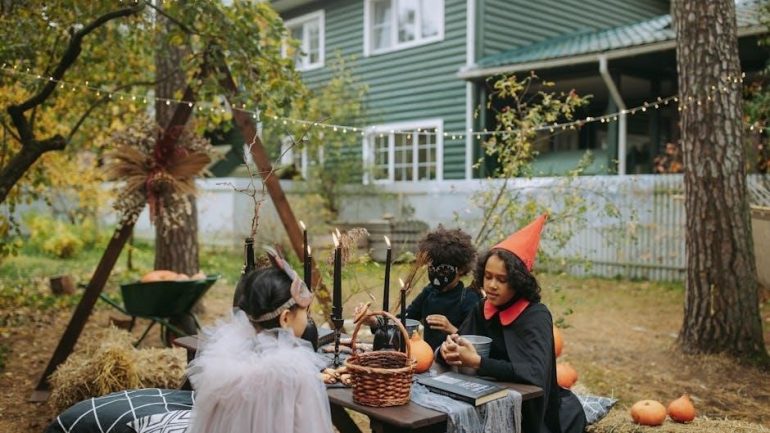Jerry Thomas⁚ The Father of American Mixology
Jerry Thomas‚ born October 30‚ 1830‚ and passing on December 15‚ 1885‚ is celebrated as the founding father of American mixology. His creativity and showmanship revolutionized bartending‚ establishing the bartender as a creative professional.
Early Life and Career
Born in Sackets Harbor‚ New York‚ in 1830‚ Jerry Thomas embarked on a career that would forever change the landscape of American bartending. His early life remains somewhat shrouded in mystery‚ but it’s known that he ventured to California during the Gold Rush era. This experience likely exposed him to diverse tastes and influences‚ shaping his innovative approach to drink mixing. He opened his first bar below Barnum’s at the age of 21.
Thomas honed his skills in various establishments across the United States‚ showcasing his flair for showmanship and creating unique concoctions. His travels and experiences contributed to his vast knowledge of spirits‚ liqueurs‚ and the art of crafting exceptional cocktails. He worked in New York City and became renowned for his skill and creativity behind the bar‚ earning a considerable sum for the time. Thomas’s dedication and passion solidified his position as a pioneer in the world of mixology.
The Professor⁚ Nickname and Reputation
Jerry Thomas earned the moniker “The Professor” due to his groundbreaking approach to bartending‚ elevating it from a mere service to an art form. His deep understanding of ingredients‚ combined with his innovative techniques‚ distinguished him from his peers. The nickname reflected the respect and admiration he garnered within the industry and among his patrons. Thomas’s reputation extended beyond his technical skills; he was known for his captivating showmanship‚ turning drink preparation into a theatrical performance.
He became synonymous with quality in the world of high-end drinks. His flamboyant style and meticulous attention to detail made him a celebrity bartender‚ attracting crowds eager to witness his mastery. Thomas’s influence stemmed from his ability to demystify the craft‚ sharing his knowledge through his seminal work‚ “The Bar-Tenders Guide‚” solidifying his legacy as a true professor of mixology. He was an inspiration to many;

The Bar-Tenders Guide⁚ How to Mix Drinks
“The Bar-Tenders Guide‚” also known as “How to Mix Drinks” or “The Bon-Vivants Companion‚” was groundbreaking. Published in 1862‚ it was the first serious American book on cocktails‚ demystifying recipes for bartenders.
Publication and Significance (1862)
Jerry Thomas’s “The Bar-Tenders Guide⁚ How to Mix Drinks‚” published in 1862‚ stands as a pivotal moment in cocktail history. This landmark volume is widely recognized as the first serious American book dedicated to the art of mixing drinks‚ solidifying its significance. Before its publication‚ cocktail recipes were largely unwritten and passed down orally within the bartending community.
Thomas’s guide changed this landscape‚ offering a codified collection of recipes and techniques. This accessibility helped standardize cocktail preparation and spread cocktail culture across the United States. Bartenders and enthusiasts could now learn and replicate popular drinks with consistent results.
The book’s impact extended beyond mere recipes. It elevated bartending from a simple service job to a profession demanding skill and knowledge. Thomas’s guide fostered a sense of pride and creativity among bartenders‚ encouraging them to experiment and develop their own signature drinks‚ thereby shaping the future of mixology.
Content and Recipes
“The Bar-Tenders Guide” is a comprehensive compilation of drink recipes‚ ranging from classic concoctions to Thomas’s original creations. The guide features a vast array of cocktails‚ punches‚ juleps‚ slings‚ toddies‚ and other mixed drinks‚ offering a glimpse into the drinking habits of the 19th century.
Within its pages‚ readers can find recipes for iconic drinks like the Blue Blazer‚ Morning Glory Cocktail‚ and Philadelphia Julep‚ each meticulously detailed with ingredients and preparation instructions. The book also includes recipes for less familiar drinks‚ showcasing the diversity of the era’s cocktail culture.
Beyond specific recipes‚ the guide offers insights into bartending techniques‚ such as the proper use of bar tools and the art of layering ingredients. Thomas provides guidance on selecting quality ingredients‚ emphasizing that “no excellent drink can be made out of anything but excellent materials.” This focus on quality and precision elevated the craft of bartending.
Impact on Cocktail Culture
“The Bar-Tenders Guide” had a profound and lasting impact on American cocktail culture. Prior to its publication‚ bartending was a largely informal and unregulated profession. Thomas’s guide provided a standardized set of recipes and techniques‚ elevating bartending to a more respected and professional level.
The book’s widespread popularity helped to popularize cocktails across the United States‚ introducing new drinks and techniques to a wider audience. By documenting and demystifying cocktail recipes‚ Thomas made it easier for bartenders and home enthusiasts alike to create and enjoy mixed drinks.
The guide also played a key role in shaping the image of the bartender as a creative professional. Thomas’s emphasis on showmanship and flair behind the bar helped to transform bartending from a simple service job into a form of entertainment. His influence can still be seen in modern bartending practices‚ where creativity and presentation are highly valued.

Key Cocktails Featured in the Guide
“The Bar-Tenders Guide” showcases a variety of classic cocktails. Among them are the Blue Blazer‚ known for its fiery presentation‚ the refreshing Morning Glory Cocktail‚ and the Philadelphia Julep‚ a minty‚ flavorful concoction.
Blue Blazer
The Blue Blazer is arguably Jerry Thomas’s most famous creation‚ a testament to his showmanship and innovative approach to mixology. This cocktail isn’t just a drink; it’s a performance. The recipe calls for whiskey and boiling water‚ but the magic lies in the dramatic preparation.
Thomas would ignite the whiskey‚ creating a mesmerizing blue flame. Then‚ with theatrical flair‚ he’d toss the flaming liquid back and forth between two silver-plated mugs‚ creating an arc of fire that captivated onlookers. This spectacle transformed the simple act of making a drink into an unforgettable experience.
The Blue Blazer perfectly embodies Thomas’s philosophy of bartending as entertainment. It’s a drink that engages all the senses‚ combining the warmth of the whiskey‚ the visual spectacle of the flames‚ and the anticipation of the final product. It’s a true testament to his legacy.
Beyond the visual appeal‚ the Blue Blazer also delivers a unique flavor profile. The heat from the flames slightly caramelizes the whiskey‚ adding depth and complexity to the drink. It’s a bold and unforgettable cocktail‚ perfect for those seeking a truly unique experience.
Morning Glory Cocktail
The Morning Glory Cocktail‚ another notable recipe from Jerry Thomas’s guide‚ presents a different facet of his mixological genius. Unlike the fiery spectacle of the Blue Blazer‚ the Morning Glory is a more refined and nuanced drink‚ showcasing Thomas’s ability to create balanced and flavorful cocktails. This cocktail is more subtle and refreshing.
The recipe typically includes whiskey‚ absinthe‚ lemon juice‚ sugar‚ and a dash of egg white. The egg white adds a silky texture and a frothy head‚ enhancing the overall mouthfeel of the drink. The absinthe provides a hint of anise‚ adding complexity and intrigue to the flavor profile.
The Morning Glory is a testament to Thomas’s understanding of how to combine different flavors and textures to create a harmonious and enjoyable cocktail. It’s a drink that can be enjoyed any time of day‚ offering a refreshing and invigorating experience. The lemon juice brightens the drink‚ while the sugar balances the tartness.
It is a reminder that Jerry Thomas was not just a showman‚ but also a skilled mixologist with a deep understanding of flavor profiles. The Morning Glory Cocktail is a classic example of his ability to create timeless and delicious drinks.
Philadelphia Julep
The Philadelphia Julep‚ as featured in Jerry Thomas’s seminal guide‚ offers a regional variation on the classic julep‚ highlighting Thomas’s attention to detail and his ability to adapt recipes to local tastes. This version distinguishes itself from other juleps through its unique combination of ingredients. The Philadelphia Julep is a testament to Thomas’s deep understanding of regional preferences.
The recipe typically calls for ingredients such as brandy‚ rum‚ peach brandy‚ and a generous amount of mint. The combination of these spirits creates a complex and aromatic base for the drink. The peach brandy adds a fruity sweetness that complements the other flavors.
The Philadelphia Julep is often served in a silver or pewter cup filled with crushed ice and garnished with fresh mint sprigs. The presentation is just as important as the taste‚ reflecting Thomas’s emphasis on the overall experience of enjoying a cocktail. It is a refreshing and flavorful drink that showcases Thomas’s creativity and expertise.
The use of multiple spirits and the inclusion of peach brandy set it apart‚ making it a distinctive and memorable cocktail. This drink is a reminder of the rich history of American cocktail culture. The Philadelphia Julep stands as a testament to Thomas’s legacy as a true innovator.

Jerry Thomas’s Legacy
Jerry Thomas’s legacy endures through his innovative techniques and the lasting influence of “The Bar-Tenders Guide.” He remains a pivotal figure‚ shaping modern bartending with his creativity and showmanship‚ leaving an indelible mark on cocktail culture.
Showmanship and Bartending Style
Jerry “The Professor” Thomas was not just a bartender; he was a true showman‚ captivating audiences with his flair and theatrical approach to mixing drinks. His bartending style was characterized by elaborate performances‚ making him a celebrity in his time. Thomas’s innovative techniques included tossing flaming cocktails and employing ornate bar tools‚ transforming the act of drink preparation into a visual spectacle.
His charisma and skill elevated the profession‚ moving it beyond simple service to an art form. Thomas understood the importance of presentation‚ ensuring each drink was not only delicious but also a feast for the eyes.
He captivated bar patrons with skilled pouring techniques‚ and flamboyant gestures.
His signature drink‚ the Blue Blazer‚ exemplified his showmanship‚ involving the dramatic pouring of flaming whiskey between two glasses. This blend of skill and entertainment cemented his reputation as a pioneer in cocktail culture.
Influence on Modern Bartending
Jerry Thomas’s influence on modern bartending is undeniable‚ establishing foundational practices still revered today. He elevated the role of the bartender‚ transforming it from a mere job to a respected profession requiring skill and creativity. Thomas’s emphasis on quality ingredients and precise techniques laid the groundwork for the modern cocktail renaissance.
His meticulous approach to crafting drinks‚ documented in “The Bar-Tenders Guide‚” provided a standardized framework for bartenders‚ ensuring consistency and quality. This pioneering work demystified cocktail recipes‚ making them accessible and encouraging experimentation. Modern bartenders continue to draw inspiration from his recipes and techniques.
Thomas’s legacy extends beyond recipes; his focus on showmanship and customer engagement remains a cornerstone of the bartending profession. His approach has inspired countless bartenders to embrace creativity‚ elevating the customer experience. Thomas’s emphasis on using excellent ingredients is still used today.

Editions and Reprints of the Guide
The enduring popularity and historical significance of Jerry Thomas’s “The Bar-Tenders Guide” have resulted in numerous editions and reprints since its original publication in 1862. These subsequent versions reflect not only the timeless appeal of the recipes but also the evolving landscape of cocktail culture. The 1887 edition‚ for instance‚ included updates and revisions reflecting new ingredients and techniques.
Modern reprints often provide valuable insights into the historical context of the guide‚ with annotations and introductions by cocktail historians. These editions cater to both professional bartenders and home enthusiasts‚ offering a glimpse into the origins of classic cocktails. The availability of these reprints ensures that Thomas’s work remains accessible to new generations.
Some editions focus on replicating the original text and layout‚ providing a faithful representation of the 19th-century bartending experience. Others offer modernized versions with updated measurements and ingredient substitutions. These editions allow us to appreciate the legacy left behind by Jerry Thomas today.




